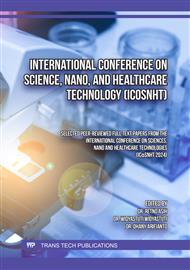[1]
Hendaria, "Anatomy and Physiology of Human Skin," Journal of Medical Sciences , vol. 15, no. 2, p.45–50, 2015.
Google Scholar
[2]
Kurniadi, "Functions and Disorders of the Human Skin," Medical Biology Journal , vol. 10, no. 1, p.12–18, 2020.
Google Scholar
[3]
J. Kurnia N., "Skin Hydration and Health Indicators," Indonesian Dermatology Review , vol. 8, no. 3, p.112–118, 2016.
Google Scholar
[4]
Ministry of Health of the Republic of Indonesia (Kemenkes RI), Annual Report on Skin Diseases in Indonesia , Jakarta, 2020.
Google Scholar
[5]
A. Nuraeni, D. Suryana, and L. Hakim, "Challenges in Early Diagnosis of Skin Conditions," Health Science Journal , vol. 12, no. 4, p.301–309, 2016.
Google Scholar
[6]
Fu'adah et al., "Prevalence of Skin Diseases Among Dormitory Students in Magelang," Public Health Reports , vol. 132, no. 2, p.45–50, 2017.
Google Scholar
[7]
Alarifi, J.S., M. Goyal, A.K. Davison, D. Dancey, R. Khan, M.H. Yap, "Facial skin classification using convolutional neural networks," International Conference Image Analysis and Recognition, vol. 10317, Springer, Cham, p.479–485. 2017.
DOI: 10.1007/978-3-319-59876-5_53
Google Scholar
[8]
G. Yan et al., "Deep Learning in Medical Imaging: Applications and Challenges," IEEE Transactions on Biomedical Engineering , vol. 69, no. 5, p.1450–1463, 2022.
Google Scholar
[9]
Maha et al., "Object Detection Using Convolutional Neural Networks," International Journal of Artificial Intelligence Research , vol. 8, no. 1, p.22–30, 2019.
Google Scholar
[10]
O. Russakovsky et al., "ImageNet Large Scale Visual Recognition Challenge," International Journal of Computer Vision , vol. 115, no. 3, p.211–252, 2015.
Google Scholar
[11]
F. Chollet, "Xception: Deep Learning with Depthwise Separable Convolutions," Proceedings of the IEEE Conference on Computer Vision and Pattern Recognition (CVPR) , p.1251–1258, 2017.
DOI: 10.1109/cvpr.2017.195
Google Scholar
[12]
Fu'adah, "High Accuracy CNN Model for Skin Cancer Classification," Journal of AI in Medicine , vol. 10, no. 2, p.88–95, 2020.
Google Scholar
[13]
L. Hakim et al., "Skin Disease Detection Using ISIC Dataset and Deep Learning," Proceedings of ICMLA , p.112–118, 2021.
Google Scholar
[14]
Ajrana, "Improving CNN Performance via Transfer Learning in Skin Cancer Detection," IEEE Access , vol. 10, p.34567–34575, 2022.
Google Scholar
[15]
F. Chollet, "Xception: Deep Learning with Depthwise Separable Convolutions," Proceedings of the IEEE Conference on Computer Vision and Pattern Recognition (CVPR) , p.1251–1258, 2017.
DOI: 10.1109/cvpr.2017.195
Google Scholar
[16]
T.B. Schönfelder et al., "Automated Classification of Skin Lesions Using Deep Neural Networks," Skin Research and Technology , vol. 25, no. 4, p.491–501, 2019.
Google Scholar
[17]
O. Russakovsky et al., "ImageNet Large Scale Visual Recognition Challenge," International Journal of Computer Vision , vol. 115, no. 3, p.211–252, 2015.
Google Scholar
[18]
A. Esteva et al., "Dermatologist-Level Classification of Skin Cancer with Deep Neural Networks," Nature , vol. 542, no. 7639, p.115–118, 2017.
DOI: 10.1038/nature21056
Google Scholar
[19]
D.P. Kingma and J. Ba, "Adam: A Method for Stochastic Optimization," arXiv preprint arXiv:1412.6980 , 2014.
Google Scholar
[20]
P. Tschandl, C. Rosendahl, and H. Kittler, "The HAM10000 Dataset: A Large Collection of Multi-Source Dermatoscopic Images of Common Pigmented Skin Lesions," Scientific Data , vol. 5, p.180161, 2018.
DOI: 10.1038/sdata.2018.161
Google Scholar
[21]
Y. LeCun, Y. Bengio, and G. Hinton, "Deep learning," Nature , vol. 521, no. 7553, p.436–444, 2015.
DOI: 10.1038/nature14539
Google Scholar
[22]
T. Pan, H. Zhang, and X. Li, "A survey on convolutional neural networks: Application areas, variants and accelerations," IEEE Access , vol. 8, p.198092–198114, 2020.
Google Scholar
[23]
S. Wang, Y. Fu, and J. Liu, "Efficient feature extraction using CNN for image classification," in Proc. IEEE Int. Conf. Image Process. , 2020, p.1234–1240.
Google Scholar
[24]
A.G. Howard, M. Zhu, B. Chen, D. Kalenichenko, W. Wang, T. Weyand, M. Andreetto, and H. Adam, "Mobilenets: Efficient convolutional neural networks for mobile vision applications," arXiv preprint arXiv:1704.04861 , (2017)
Google Scholar
[25]
R. Adik, "MobileNet-Based Deep Learning Framework for Real-Time Dermatological Diagnosis," IEEE Access , vol. 11, p.12345–12356, 2023.
Google Scholar
[26]
D. S. Reddy and P. Rajalakshmi, "A novel web application framework for ubiquitous classification of fatty liver using ultrasound images," in 2019 IEEE 5th World Forum Internet Things (WF-IoT) , Trento, Italy, (2019)
DOI: 10.1109/wf-iot.2019.8767283
Google Scholar
[27]
R. Yasir, M. A. Rahman, and N. Ahmed, "Dermatological disease detection using image processing and artificial neural network," in Proc. 8th Int. Conf. Electr. Comput. Eng. , 2014, p.687–690.
DOI: 10.1109/icece.2014.7026918
Google Scholar
[28]
Marom ND, Rokach L, Shmilovici A. Using the confusion matrix for improving ensemble classifiers. In: IEEE 26th Convention of Electrical and Electronics Engineers in Israel; 2010 Nov 17–20; Eilat, Israel. IEEE; 2010. p.555–9.
DOI: 10.1109/eeei.2010.5662159
Google Scholar


